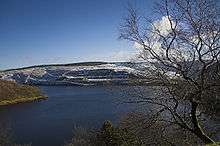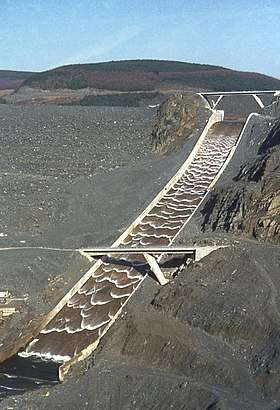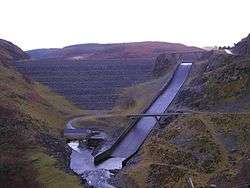Llyn Brianne
Llyn Brianne is a man-made lake or reservoir in the headwaters of the River Tywi in Wales.


| Llyn Brianne | |
|---|---|
 The Llyn Brianne rock-fill dam | |
| Location | Wales |
| Coordinates | 52°8′N 3°45′W |
| Type | reservoir |
| Basin countries | United Kingdom |
Construction
The reservoir was constructed by Wimpey Construction in the late 1960s and early 1970s[1] in order to regulate the flow in the Tywi to support large potable water abstraction at Nantgaredig in the lower reaches of the river near Carmarthen; providing water to the Felindre water treatment works. The treated water is piped to a large area of South Wales which includes Swansea and Neath and the western periphery of Cardiff.
Structure
The dam is of crushed rock, larger rock and clay; all materials having been obtained in the area. In essence, it is a constructed mountain blocking the valley. The clay was harvested higher up the valley near Soar y mynydd chapel closer to Tregaron. Much of the rock was harvested at the site. An on-site stone-crusher was used to reduce larger rocks to the various sizes required. A round-the-clock labouring system enabled its completion almost two years ahead of schedule.
Fish conservation
Because of the importance of the River Towy salmon and trout fisheries, special protective measures were incorporated into the construction of the reservoir including a smolt trap and a restocking programme using artificially raised parr. Releases of water from the dam tend to be very cold and are also blamed by anglers for a reduction in the quality of the fishery.
Hydroelectric scheme
The spillway of the dam is a notable tourist attraction when the reservoir is spilling. The dam is the UK's tallest, standing at a height of 300 ft (91 m). In 1996 the reservoir spillway was increased by 1 metre in height and a hydro electric generating station was added at the base of the dam. When all three turbines are working, it generates 4.60 megawatts of electricity.[2]
Under the reservoir there are a couple of flooded houses. Before the water level was raised, it was possible to walk to Fannog farmhouse; a "For Sale" sign was once erected on it. It is still possible to see the roof when the water level is low.
Kayaking
The spillway has recently been used by kayakers to slide down while the water is in flood. However this specific activity is banned by Welsh Water, and they issued a statement in 2008 calling the practice "dangerous" and stating that such activities were banned at the reservoir. However, non-motorised water craft are permitted on the actual reservoir.[3]
References
- Engineering Timelines
- Our operations Archived 2013-10-14 at the Wayback Machine Infinis
- "Kayakers' 300ft dam drop attacked". BBC. 2008-11-18. Retrieved 2008-11-18.
Further reading
- Lillicrap, R. J. The Llyn Brianne Dam and the River Towy Scheme. Llandovery: Llandovery Publications, 1998.